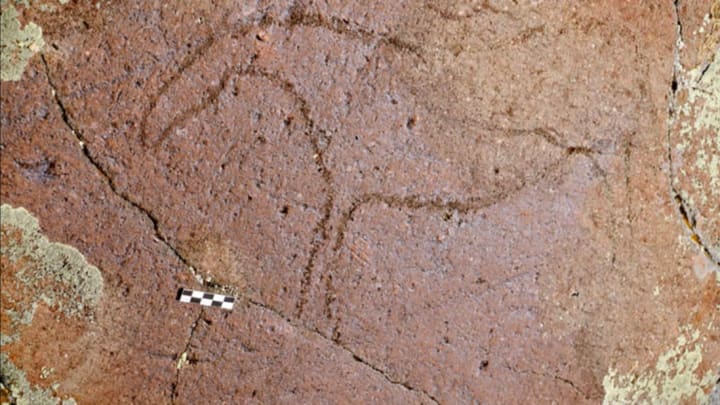A new analysis of intriguing rock art has archaeologists wondering whether they've found the earliest petroglyphs in Siberia, according to The Siberian Times. First discovered in 1992 on the Ukok Plateau—a remote, high-elevation region of grasslands in the Altai Mountains near Russia's border with China, Kazakhstan, and Mongolia—the petroglyphs have gotten a new look this summer by archaeologists from Novosibirsk State University, with assistance from some French colleagues.
The petroglyphs, which depict horses and bison, were carved into glacier-polished rhyolite, a volcanic rock. The wind-swept plateau has little sediment for archaeologists to date, so they looked for help from geomorphologists, who determined when glaciers retreated from the site. They say that could have happened between 8000 and 10,000 years ago. If the rock art is that ancient, it's thousands of years older than any other known rock art in Siberia.
"We have converging data suggesting that the petroglyphs could be Paleolithic and thus the most ancient known in Siberia," NSU's Lidia Zotkina told the Siberian Times. "When the French archaeologists first arrived on the Ukok Plateau and saw the petroglyphs they said: 'If we had found them somewhere in France, we would not doubt they are Paleolithic, but here, in Siberia, we need to ascertain their age.'"
They're currently testing to see whether the etchings were made by stone or metal tools. Stone tools would indicate an early age, though not necessarily as old as the Paleolithic. Metal tools, however, would firmly place the petroglyphs in a far more modern era. So far, the tests seem to indicate they were made with stone tools.
The Ukok Plateau is a UNESCO World Heritage Site that is well established as a region that different peoples called home for millennia. Its most famous resident by far is the so-called Ice Maiden (also known as the Princess of Ukok), whose elaborately tattooed skin has made her famous since she was discovered on the plateau in 1993, her remains having been immaculately preserved by the permafrost for more than 2500 years. She is believed to have been a member of the Pazryk people, and probably died at around age 25.
